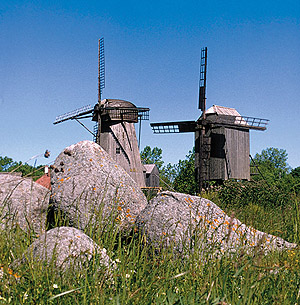|

|
|
Saaremaa, Estonia's largest island [File photo]
|
The most familiar tourist destination in Estonia is the capital city, Tallinn. Each year, thousands of tourists flock to the city on the northern coast.
But the country has far more to offer visitors, especially its charming Baltic Sea islands.
The largest of these islands is Saaremaa, about a two-hour drive from Tallinn, which must be followed by a ferry trip to Muhu and a journey along a dam. About 2,000 people live on the island.
In 1534, Muhu was the location where the first book was printed in the Estonian language - The Bible.
Muhu has long been populated mainly by farmers: "One home would house 20 or 25 people, as well as farm animals," says Katrin Vaikmaa of Muhu's open-air museum, where guests are greeted in wooden huts with thatched roofs.
The islands are popular today among Estonian tourists, with many visiting the island communities every year on June 24, St John's Day. On that day, ferries are brimming with passengers.
Free access to the Internet is in theory legally guaranteed across Estonia. There's even a "WiFi Area" sign hanging on the wall of a 14th-century castle in the town of Kuressaare. That castle is today a museum, with a display that shows the islands' history.
The best time to visit Estonia is during the summer months, when it's warm and dry on the islands.
However, it's also the most expensive time to visit. Simple accommodation, such as a basic double room, goes for a price that many western Europeans would expect to pay for a four-star evening meal.
Business is so good that many locals on Hiiumaa island also rent out rooms in their homes to tourists.
Sheep and wool production are two things Hiiumaa is renowned for throughout the Baltic region.
The wool is taken to Vaemla, where it's turned into garments using old-fashioned machinery.
"We keep them going for the tourists, but also because they continue to work," says Juri Valdma, a 63-year-old who likes chatting to visitors.
Old awards and flags hanging from the walls show that the machinery has been operating since the Soviet era. One testimonial says that the factory fulfilled its quota by 128 percent.
But is there still a living to be earned from making woolen clothes? Valdma smiles in reply and slaps his hands against his plump belly.
Woolen socks sell for a couple of euros, pullovers cost a little more and even hats made from felt sell well.
Estonia's islands are popular with ramblers, ideal for horseback riding and suitable for cyclists, thanks to paths that are not too steep. Even water sports enthusiasts will feel at home here.
"A growing number of people are coming to visit us here. Mostly Estonians, but also Swedes and Germans," says Ivar Juessi, who offers kayak tours.
Juessi takes his guests to the smaller islands where abandoned farmsteads have been left intact as open-air museums.
This part of western Estonia is like a scene from a novel by the Swedish children's author Astrid Lindgren. No wonder - the woman who illustrated almost all of her books, Ilon Wikland, spent her childhood here.
(China Daily September 18, 2008)